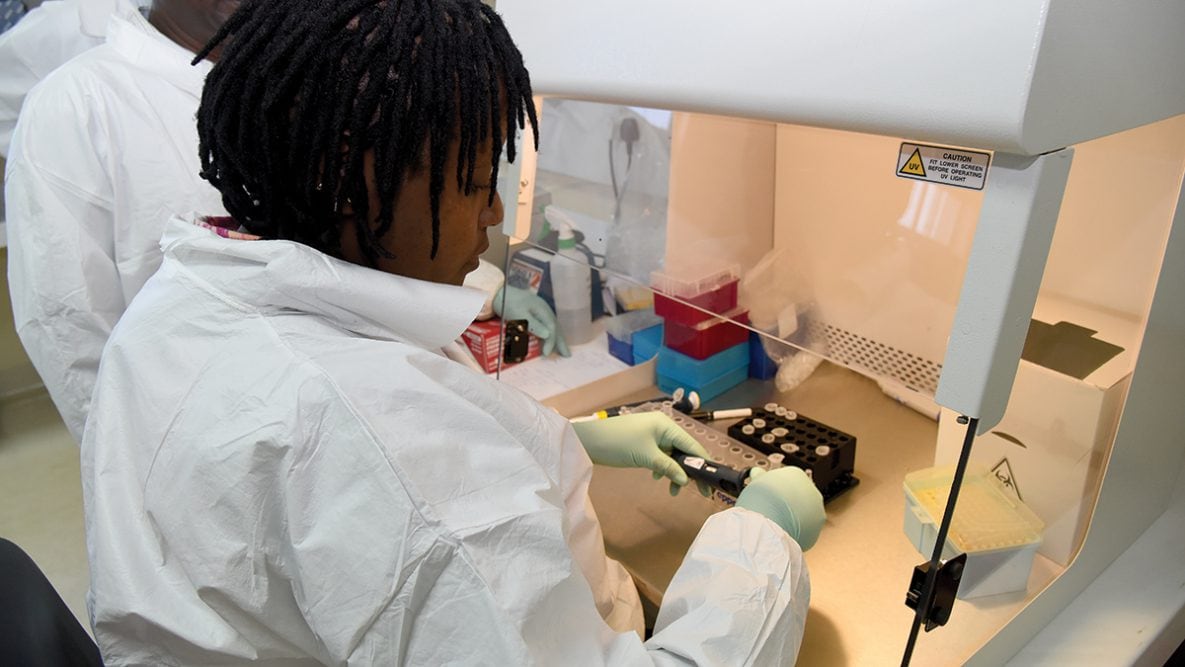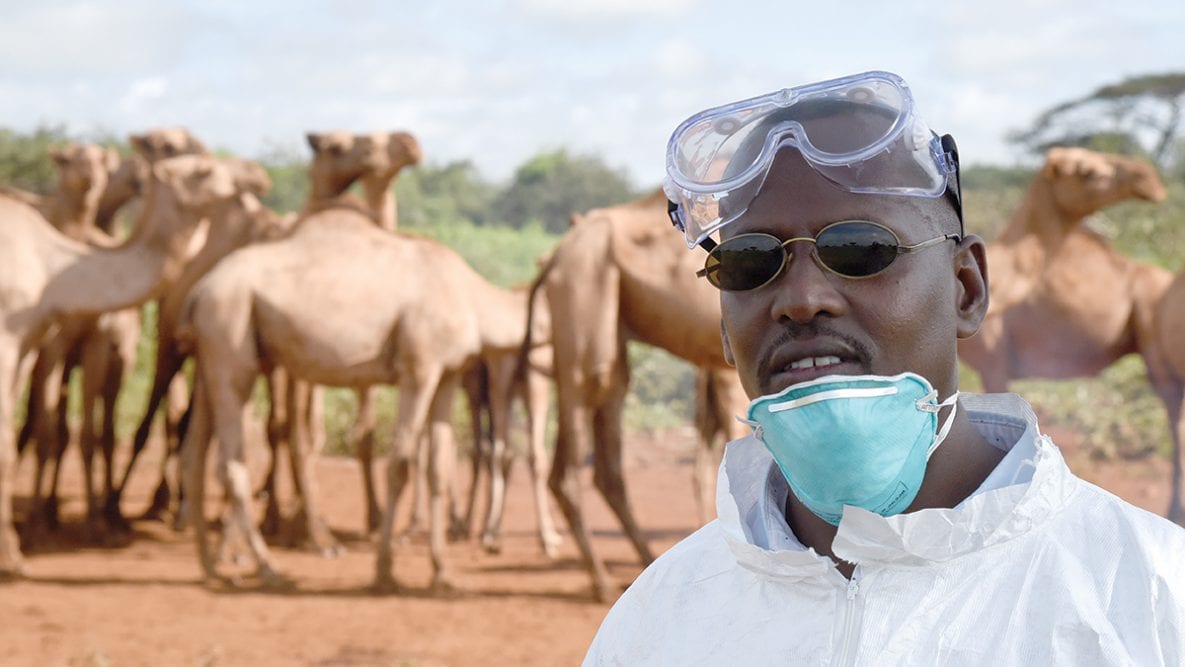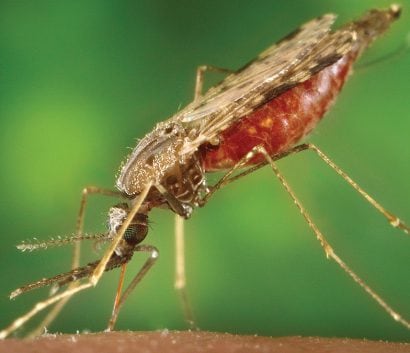CDC Kenya Science


CDC Kenya conducts and translates research to inform policy and practice both in Kenya and globally; and to monitor and evaluate activities that ensure cost-effective health impact.

In Kenya, malaria remains a leading cause of illness and death. Since 1979, CDC has collaborated on malaria research projects in western Kenya, which harbors the largest burden of disease in the country. In 2018, CDC Kenya’s malaria research program made headway in evaluating new prevention and treatment tools in the fight against malaria.
New study shows drug that kills mosquitoes could be used to fight malaria
One of these studies has shown the potential impact of a new drug strategy for breaking the transmission cycle of malaria. The study showed that when a mosquito bites a person who has taken ivermectin, an anti-parasitic drug, within the last 28 days, that the mosquito dies, thus breaking the malaria transmission cycle. This differs from existing drugs that target the parasite to reduce the spread of malaria.
For this study a team of scientists from CDC Kenya, KEMRI, the Liverpool School of Tropical Medicine (LSTM), and other organizations, carried out a randomized controlled trial. The results were published in June 2018 in Lancet Infectious Diseases, and show that adding high doses of ivermectin to the antimalarial dihydroartemisinin-piperaquine (DP) has a major and prolonged effect on mosquito mortality.
“This first evaluation of the impact of high dose ivermectin on mosquito mortality is highly encouraging and requires further evaluation in larger scale trials that target both malaria parasites and the mosquitos, as the world pushes towards malaria elimination”, explained LSTM’s Professor Feiko ter Kuile, senior author of the paper.
Ramping up disease surveillance
Disease surveillance systems are the backbone of all public health systems providing the data necessary to monitor trends, show the impact of interventions, estimate testing and treatment commodity needs, and identify and respond to outbreaks. Malaria surveillance poses a specific challenge; the majority of cases of malaria in western Kenya do not result in disease, and therefore case counts at health facilities substantially underestimate the burden in the community. Cross-sectional studies, which have traditionally been the gold-standard, are not sustainable due to their expense.
Understanding this, CDC invested resources over the last 3 years to investigate both new systems and novel ways for using existing systems to monitor malaria in the community. The first step was creating a continuous malaria indicator survey (cMIS) that is used for collecting data every working day of the year. This system provides the gold-standard for testing whether other approaches can accurately detect real-time trends in malaria infection. Next, the team focused on evaluating more sustainable methods for performing malaria surveillance. One such method determines whether positive malaria tests in pregnant women attending their first antenatal care (ANC) clinic visit accurately estimate malaria infection prevalence in the community. After 2.5 years of data collection, analyses demonstrates that women attending first ANC clinic visits show a strong correlation with community infection prevalence and may supplement existing surveillance systems. Initial study results were presented at the 2018 American Society of Tropical Medicine and Hygiene Annual Conference in New Orleans. Based upon this cutting-edge work in Kenya, the President’s Malaria Initiative is performing pilot evaluations in four other sub-Saharan African countries.
The CDC team’s next challenge is to evaluate use of this system to identify hotspots of malaria disease, and direct the appropriate response for targeted interventions. This important work has begun in earnest and will be the focus of the CDC Kenya’s malaria surveillance studies for 2019 and 2020.
Tuberculosis (TB) is the leading infectious disease killer in the world. According to the World Health Organization (WHO), 1.6 million people died from the disease in 2017, including 230,000 children1. One key to controlling TB is effective testing of those showing the signs and symptoms. While sputum smear microscopy remains the foundation of TB diagnosis in low- and middle-income countries, the test sensitivity is poor, especially in people living with HIV. Mycobacterial culture is considered the gold standard for definitive diagnosis of TB but it proves challenging in poorly resourced settings. Clinicians and public health officials urgently need new and improved tools for diagnosing TB.
CDC Kenya, in collaboration with the Kenya Medical Research Institute (KEMRI) and the Clinical Diagnostics Research Consortium, participated in a landmark multi-country evaluation of the molecular TB diagnostic assay, Xpert MTB/RIF Ultra (Xpert Ultra). Funded by the U.S. National Institutes of Health (NIH), this was the first prospective study on the accuracy of Xpert Ultra for pulmonary (involving the lungs) TB and the detection of drug resistance. The study showed that Xpert Ultra was a superior test in diagnosing TB. Additionally, Xpert Ultra did not require any equipment changes to the existing GeneXpert technology beyond a new cartridge.
The findings of this study, published in Lancet Infectious Diseases2, were used by the WHO to endorse Xpert Ultra for TB diagnosis for all adults and children with signs of TB.
1 WHO—https://www.who.int/news-room/fact-sheets/detail/tuberculosis
2 Findings from this landmark study were used by WHO to endorse Xpert Ultra for TB diagnosis for all adults and children with signs and symptoms of TB.
The Kenya Field Epidemiology and Laboratory Training Program (FELTP) is a 2-year training program that aims to improve national and county level public health systems by building advanced skills in applied epidemiology and laboratory management among a variety of healthcare professionals. The Kenya FELTP began in 2004 and has since trained over 300 healthcare professionals who, while in the program, contribute significantly to investigating and responding to major outbreak investigations including Rift Valley fever (RVF), polio, and measles across the country.
Ngina Kisengau, a recent FELTP graduate and clinician by training, successfully responded to the challenge of evaluating an outbreak of viral hepatitis B in Makueni County. During her time as a FELTP resident, she was alerted of a suspected hepatitis B outbreak in a county prison and became concerned about how it might increase the risk of hepatitis B infection among healthcare workers. Unfortunately, data on the prevalence of hepatitis B virus infection and vaccination rates in African healthcare workers are limited. Therefore, the Kenya FELTP (in collaboration with KEMRI, CDC and the Makueni County Government) proceeded to investigate vaccination rates and factors associated with hepatitis B vaccination among healthcare workers.
As part of the investigation, Ngina surveyed over 300 healthcare workers in 42 health centers, clinics and dispensaries throughout the county and tested blood specimens from 95% of the respondents for signs of immunity against hepatitis B virus. The survey and blood tests helped to identify health workers that were less likely to be vaccinated against hepatitis B. Results indicated that although 80% of workers had received at least one dose of the hepatitis B vaccine, about half of those vaccinated did not receive all three recommended doses primarily because the vaccine was not readily available. Also, cleaners and waste handlers were less likely to be vaccinated compared to nurses, doctors, and laboratorians. These valuable conclusions were shared with county representatives and ultimately published in the Oxford Journal of Public Health in October 2018.
Ngina’s study also motivated Makueni County to acquire additional doses of hepatitis B vaccine for healthcare workers. Thanks to Ngina’s use of evidence-based data, she was ultimately able to protect the health of her fellow healthcare workers and influence vaccination efforts across Makueni County.

“The FELTP program imparted me with key practical skills in public health surveillance and data analysis that I use in my work everyday.” Dr. Ngina Kisengau
Young women and adolescent girls remain at high risk for HIV, and prevention methods that are both acceptable and accessible to them are critical to their well-being. Over the past 10 years, public health officials and researchers have made progress in preventing new HIV infections through the use of innovative methods. Additionally, many women are seeking contraception to prevent pregnancy. New research is looking at combined methods that offer dual protection from both HIV and pregnancy.
The Western Kenya Clinical Research site, a collaboration between CDC Kenya and KEMRI, has been conducting high-quality clinical research studies for more than a decade and in recent years has contributed data to more than a dozen multisite international HIV and TB clinical trials.
Two important studies sponsored by the National Institutes of Health (NIH)’s HIV Prevention Trials Network (HPTN) are currently underway, one of which has already reached its target enrollment of participants: the Antibody Mediated Prevention (AMP) study which looks at the effectiveness of a monoclonal antibody for the prevention of HIV; and the Long-acting Injectable For the Epidemic (LIFE) study which evaluates the safety and efficacy of an injectable antiretroviral, Cabotegravir, for HIV prevention in women.
Further plans are underway to launch two more studies that will use an intravaginal ring to prevent HIV in women. The recent study includes a ring that contains both an agent to prevent HIV infection and a hormonal contraceptive. Additionally, the NIH’s Microbicide Trials Network’s REACH (Reversing the Epidemic in Africa with Choices in Prevention) study will compare adherence to an intravaginal ring that has an antiretroviral drug and daily oral pre-exposure prophylaxis targeting women between the ages of 16-21 years.
These studies will help protect and empower adolescent girls and young women in Kenya and around the world from getting HIV.
Next Generation Sequencing (NGS), a technology that allows DNA and RNA to be sequenced much more quickly and cheaply, is rapidly changing the practice of microbiology. NGS capacity in public health laboratories is one of the most important advances in diagnosing infectious diseases over the last three decades because it gives each pathogen a unique fingerprint.
In 2018, CDC established NGS capacity in Kenya to detect bacterial pathogens. The teams involved worked concurrently in two of CDC’s Global Disease Detection sites in Kenya and Thailand to develop this advanced capacity, provide training, and supply the required NGS equipment. Initial implementation included sequencing of Salmonella bacterial isolates to highlight the resistance patterns to commonly used antibiotics. The process tracks circulating bacteria in time and space, providing data which can be used to prevent spread and thus reduce disease in the Kenyan population.
Every year, Kenya experiences disease outbreaks from various pathogens. Often, health experts are unable to determine which disease is causing the outbreak. Incorporating NGS technology in the diagnostic capacity now allows CDC to sequence an entire pathogen genome to identify whether the pathogen is viral or bacterial, characterize its antimicrobial resistance, determine factors that increase the pathogen’s ability to cause severe disease as well as its typing and molecular epidemiology in the public health laboratory. This advanced technology, however, can be difficult to implement without the appropriate laboratory infrastructure and human resources.
Implementing NGS in Kenya has enabled laboratorians to become self-sufficient and problem-solve issues without external expertise. Once programs implement sequencing as a routine diagnostic technique for one enteric bacterial pathogen, the same methods may be applied for other bacterial pathogens. Scientists hope that this approach will set the stage for progression towards more complex NGS procedures including testing of a broader range of specimens, and increase capacity for detecting novel pathogens.
Expectant mothers are among those most at risk of developing serious complications from influenza (flu). When a woman becomes pregnant, changes to her immune system, heart, and lungs make her more prone to severe illness from flu, including illness resulting in hospitalization.
In 2012, the World Health Organization (WHO) recommended that pregnant women should have the highest priority for seasonal flu vaccination in countries starting or expanding flu immunization programs. This is because flu vaccine has a long track record of safety when administered during pregnancy and is the best way to protect expectant mothers from the effects of flu. Moreover, when a pregnant woman is vaccinated, she produces protective antibodies against flu that are passed in-utero to her baby, protecting newborns from flu for the first several months of life. Infants younger than 6 months of age are too young to be vaccinated, but also are at high risk of serious flu complications, so the protection gained from their mother’s vaccination is very important.
To guide the Kenya government as it considers expanding its flu vaccination program to include pregnant women, CDC Kenya—in collaboration with the Kenya Medical Research Institute (KEMRI)—is leading a demonstration project to vaccinate pregnant women in Kenya’s Siaya County. The study aims to enroll more than 400 pregnant women, give them a flu vaccine and measure how well they develop immune protection after vaccination as well as measure the flu antibodies transferred in utero to the babies. The study includes vaccinating pregnant women who are HIV+ or who had malaria when vaccinated. The study began in June 2018 and has already enrolled more than 100 mothers. The study team relate that pregnant women participating in the project have had positive experiences, and many have encouraged other pregnant women to participate in the study.
Kenya has not yet adopted a flu vaccine recommendation for pregnant women, partly due to lack of local data to support such a policy. The current recommendation of the Kenya National Immunization Technical Advisory Group (KENITAG) focuses on children 6 to 23 months of age due to the high number of flu cases among very young children. KENITAG has also requested country-driven data on the impact of flu among pregnant women and their babies, emphasizing the need to understand if the flu vaccine would work as well in mothers who suffer from HIV or malaria, and if these mothers would transfer antibodies against flu to their babies.
CDC expects that findings from this study will inform decision-making by the Kenya Ministry of Health on the adoption of a flu vaccination policy for pregnant women. If adopted, this policy will serve as an important public health step in Kenya, and serve as an example to other countries in the region.